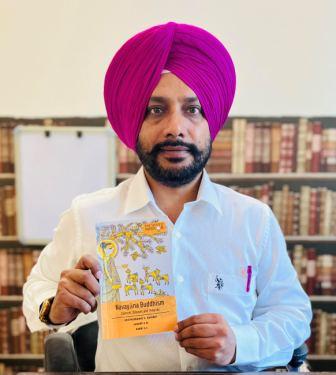Dr Jas Simran Kehal
The concluding pages of the book states that as much as Babasaheb chose Buddhism, Buddhism also chose Babasaheb. Does that mean that in order to be an Ambedkarite, I have to follow Babasaheb’s Buddhism? May be, yes. And the affirmation was clear after going through the first few pages of this book.
It would be wrong to accept that I have not been pursuing Buddhism after getting influenced by the life and writings of Dr Ambedkar. Born as a Sikh at the temporal seat of Sikhism—Sri Anandpur Sahib—the birth place of Khalsa and practicing around the same place, I am witness to the social degeneration and disintegration in society. It is common nowadays to find multiple and separate gurudwaras as well as cremation grounds for different castes and sub-castes in a single village.
My pursuit of Buddhism took me to places like Dharamshala, Bhutan, Southeast Asia and even Japan, but frankly their practices, rituals, liturgy and monastic structure couldn’t get me an exit route from my religion of birth. All I found was mythology and reincarnation theories.
In another failed attempt, my anesthetist was my accomplice, under whose persuasion I attended a Vipassana session. I confess I couldn’t concentrate. How could I? Amidst such social and spiritual turbulence everywhere, I desired only a clear and concise way out.
At last, I went through The Buddha and his Dhamma and have no qualms in admitting that I could not contemplate or relate to the book and ended up as an atheist a couple of years ago.
This book published by The Shared Mirror Publishing House titled Navayana Buddhism: Context, Debates and Theories, by Shaileshkumar S. Darokar, Subodh N.W. and Bodhi S.R. changed my perceptions about Buddhism as a whole and Navayana in particular.
The introductory note mentions that the authors had two possible readers in mind. Firstly, the general reader who is inquisitive about Babasaheb’s Buddhism, and second reader is the follower of Babasaheb, who values his embracing the Buddha-Dhamma and wants an elaborative interpretation of his intellectual thoughts.
This book carries a wider scope for readers than the authors originally had conceived. The content is descriptive enough to coerce a novice like me to understand and embrace Babasaheb’s Buddhism. I guess it also carries clarified views for those who are already treading the Navayana path or are mistakenly into other types of Buddhism.
I am going to provide you with excerpts of this book so as to have a better understanding of Dr Ambedkar’s Buddhism as interpreted by these three Navayana Buddhist intellectuals. Believe me, there are umpteen numbers of reasons to read it. Here are some of them:—
Starting from the basics, it defines religion according to Babasaheb and how he considered it important for society.
Read this book if you want to know the basic parameters to judge a good religion. If your religion is falling short on those parameters, get to know the methods of reforms suggested by Babasaheb.
Navayana widens the scope of religion from what was a conventionally thought of as being a personal matter (man to God) to the more comprehensive social sphere. It redefines religion, sets up a new framework to judge and execute reforms.
Detailing reasons that led Babasaheb Ambedkar to embrace Buddhism, the authors clarify that Babasaheb was looking for a margadata rather than a mokshadata. His new vehicle religion purged the concept of God from Buddhism and introduced Dhamma and morality in its place.
For Babasaheb, what God is to other religions, morality is to Dhamma.
The authors interpret Navayana Buddhism with Tri-ratana of Buddha-Dhamma-Sangha as its framework. They further represent:
Buddha- liberty, freedom, awakening
Dhamma- law of equality
Sangha- an enlightened fraternity
Dr Ambedkar emphasized on cultivation of mind, and this book explains the four basic methods Navayana practitioners employ to attain insight and wisdom. These are worth emulating.
Ambedkar’s Buddhism does not teach us to follow Buddha sitting with eyes closed and do Vipassana (meditation) but to follow what Buddha teaches us to see the world with open eyes and samyak drishti (an attitude of equality and stability).
The authors conduct an epistemological enquiry into Buddhist philosophy concluding that pradnya, karuna and samata are its three fundamentals. They consider Buddhism as an epistemological revolution and claim Navayana turned people who were recipients of knowledge into producers of knowledge.
Babasaheb gave back to the whole world the epistemology of Buddha after a thorough cleansing of its historical alteration, ontological manipulation and theoretical distortions, subjecting every historio-theoretical proposition of Buddha to the test of rationality, welfare, justice and the most fundamental test of all—the test of equality.
At last, if one wants a detailed and simplified explanation of the Buddhist way of life proposed by Babasaheb in his last book The Buddha and his Dhamma one can take help of this one.
It provides an expert opinion on Babasaheb’s Buddha by those who have been practicing it for last 65 years and how Buddha’s panchsheel and das-parimitas along with Babasaheb’s 22 vows can lead to holistic development of society. Right from the basic concept of atta deepo bhava to difference between Dhamma and religion, and revolution enforced by Dhammakranti in 1956, this book is total package.
Part of this experience of Navayana Buddhism may have been told before, but never with such freshness, elaboration and plain-sailing. An important part I found missing was a comprehensive glossary of difficult words which would have been a great help for a beginner like me. Furthermore, a critical analysis is awaited from experts like Dr Amritpal Kaur whom I consider my mentor in this field.
For people like me, who comes from a religion where God occupies a central place in the belief system and held the view that the Buddha is a God or supernatural being, this book gives a clear understanding of what Buddha-Dhamma-Sangha stands for. If this book had come earlier I would have been a practicing Buddhist, perhaps one of the few born as a Sikh.
Indeed, I was living under a set of religious rules and got exposed to principles of Navayana by going through this book published by The Shared Mirror.
~~~
Dr Jas Simran Kehal is an Orthopaedic surgeon at Nangal Dam, Punjab and a Masters in Journalism and Mass Communications. He is currently pursuing Masters in Ambedkar thoughts.









